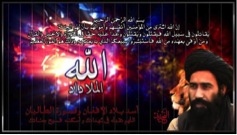
This specific image is intended to commemorate a senior Taliban military commander, Mullah Dad Allah (also known as Dadullah), and therefore contains some of the traditional Muslim funerary epigraphy. Dadullah was killed by U.S. and UK special operatives on December 5, 2007. At the top appears the basmala (the phrase “bi-smi Allah al-rahman al-rahim,” or “in the name of God the merciful and compassionate”), followed by a quote from the Qur’an (9:111): “inna Allah ishtara min al-mu’minin anfusahu wa-amwalahum bi-anna la-hum al-janna, yuqatiluna fi sabil Allah, fa-yaqtulun wa-yuaqtalun wa‘dan ‘alayhi haqqan fi al-tawra wal-injil wal-qur’an; wa-man awfa bi-‘ahdihi min Allah, fa-istabshiru bi-bay‘ikum lladhi baya‘tum bi-hi wa-dhalika huwa al-fawz al-‘azim” (“Indeed Allah has bartered with the believers, for their souls and possessions, theirs is paradise; they fight in God’s path, they kill and are killed, based on a promise, a truth, in the Bible, the Gospel and the Qur’an—and who is more faithful to his promise than God? so delight in the deal you have struck, for that [bargain] is a great attainment”). In the middle of the image, against the background of light and flames, appears the figure’s name: al-Mullah Dad Allah. In red at the bottom is the rest of the caption: “Asad bilad al-afghan wa-qa—al-taliban, allahumma, taqabbalhu fi shuhada’ika, wa-askinhu fasih jannatika” (“Mullah Dad Allah, the lion of Afghanistan and—of the Taliban, O God, accept him among your martyrs and place him in the most spacious of your heavenly gardens”).
The lion in the image is an important motif in Islamic art and culture that evokes the qualities of bravery, strength and valor for Muslim audiences. The motif recurs in various Islamic sources, including the Qur’an, hadith (prophetic traditions) and classical Arabic poetry. For instance, medieval Muslim historiographers and theologians compared the divine voice that was heard in Mecca during the time of the Prophet to that of a lion roaring in the desert, and mused about the notion of an eschatological peace that, like in Judaism, is illustrated by the phrase “the lion will lie down with the lamb.” In the modern era, the lion symbol has been employed by influential authors like Sayyid Qutb, and it has become a key motif in jihadist propaganda.
 Skip to content
Skip to content
